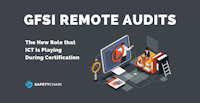GFSI Officially Sanctions Remote Auditing
Recently, GFSI updated its stance on the use of Information and Communications Technologies (ICT) in the audit process and is now allowing part of its certification audits to be conducted remotely. Here’s a summary of the events leading up to this change and a breakdown of what it means for food and beverage manufacturers.
Chronology of GFSI Benchmarking Requirements Changes
In March of 2020, GFSI announced a near-term response to the Coronavirus pandemic and created a forum to explore the use of remote and virtual technologies during certification audits. In April of 2020, it proposed amendments to its Benchmarking Requirements that offered solutions to certification delays stemming from COVID-19 travel restrictions and put a vote out to its public stakeholders.
On June 11, 2020, GFSI posted a letter from leadership announcing its support of using Information and Communications Technologies (ICT) during audits. A subversion of its Benchmarking Requirements were updated as well, allowing each Certification Program Owner (CPO), such as SQF, FSSC, BRCGS, and so forth, to develop their own remote auditing procedures.
Today, CPOs can submit their remote audit guidelines to GFSI for assessment against its 2020 Benchmarking Requirements. Once published, remote audits can begin.
COVID-19 Accelerated But Did Not Precipitate Benchmarking Requirements Update
Although the logistical certification roadblocks that COVID-19 threw in CPO’s, CB’s and food/beverage manufacturers’ way accelerated GFSI's conversations about remote auditing, GFSI had been evaluating the value of using ICT in audits for some time. This “new world of auditing” as described on the GFSI website is neither temporary nor short-lived, and offers many conveniences and benefits:
“The new requirements on remote auditing are not designed to be an answer to the impact of the COVID-19 pandemic on audits; rather that was the purpose of our position issued on 16th March. GFSI acknowledges the increasing role and potential of technologies to support auditing. However, GFSI has accelerated the work to allow for the use of Information and Communications Technologies (ICT) in audits and also in auditor assessment. While many of the processes that will be formalized in the coming months will help in the post-pandemic world, we anticipate they will also support food producers and auditors into the future as well.”
Remote Auditing Adds Convenience, Speed, & Cost-Savings to Certification Process
The time and money F&B companies will save with the ability to conduct a portion of their audits remotely is substantial. This change will modernize and streamline what has historically been a laborious and sometimes stressful process, while significantly reducing the Certifying Bodies’ transportation costs. And, for Eurofins Food Assurance customers, the technology needed to carry out the process is provided free via a partnership with SafetyChain Software.
Benefits to Conducting Part of Your Certification Audits Remotely
Savings on travel expenses (sometimes up to 50%)
Health safety concerns: keep staff and auditors safe; avoid risk of plant shutdown
Faster/easier prep: get advanced notice of what is needed and time to organize & upload documents
Ability to do audits with fewer resources: don't have to pull valuable (limited) resources off the floor for an audit
Long-term record access: easier access for auditors to review prior records; gives client ability to trend progress
Transparency / accountability with co-workers: give execs/managers real-time insight into status and outcomes of the audit
Secure cloud storage: safe, secure centralized storage of audit records only accessible by customer and assigned auditor
What Are the Requirements for a GFSI Remote Audit?
To help you navigate the new era of remote auditing, here are a few key points to be aware of:
There must be a mutual agreement between both the CB and the site for a portion of the audit to be conducted remotely.
The CPO will decide which part(s) of the audit may be conducted remotely. Audits will continue to have a required onsite component, including an inspection and physical verification of Good Manufacturing Practices and verification that the Food Safety Management System “addresses all applicable parts of the operation” (clause 5.32).
Each CPO must continue to use IAF MD4 as a normative reference (clause 4.6.1).
The duration of audits will be adjusted to allow for adequate time to be spent on both the remote and onsite portions. The onsite portion should be conducted no later than 30 days after the remote portion. With an approved risk assessment, the length between remote and onsite portions can be extended to 90 days.
The use of technology must be considered for communication, data gathering, and information storage during the remote portion of the audit.
The examination of products and processes may occur at the time of the remote activity.
Auditors will be monitored using remote technology to ensure proper conduct.
The CPO must still verify that the company implements corrective action plans effectively. However, remote technologies may be used for verification of corrective actions.
Witness audits, a key part of initial auditor qualification, will not be conducted remotely.
Webinar to Explain the New GFSI Stance on Remote Audits
Of course, even with these guidelines, many food and beverage leaders still have questions. SafetyChain and Eurofins have partnered to provide manufacturers and processors a detailed explanation of GFSI’s newest benchmarking requirements as they apply to remote auditing and help them get started saving time and money by conducting part of their audits remotely.
Join us on July 16, 2020 – we look forward to exploring this new chapter of auditing together.
For More Information
If you'd like to learn other ways to leverage technology to manage GFSI requirements, see our post, 4 Ways to Leverage Food Safety Technology to Manage GFSI Requirements. For a better understanding of the overall GFSI certification process, read A Guide to GFSI Compliance and Certification.


